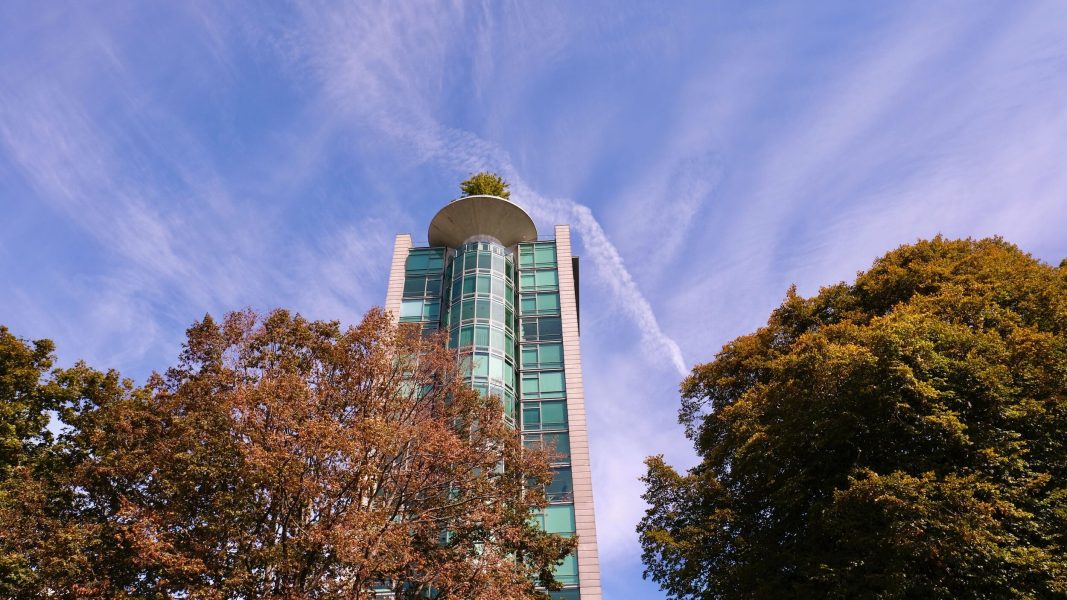
Richard Henriquez – Building Stories
Review By Kelvin Lit
August 23, 2023
BC Studies no. 218 Summer 2023 | p. 123-125
Richard Henriquez – Building Stories, by Mike Bernard and Gavin Froome, is a documentary on the work of Vancouver based Architect Richard Henriquez and its legacy. The documentary provides a compelling portrait of Henriquez’s architectural practice – one that has provided Vancouver with some of its most important and culturally significant buildings. Indeed, for many, Vancouver cannot be imagined without the iconic Eugenia Place overlooking English Bay, or the Sylvia Tower, the False Creek Housing Cooperative, Gaslight Square in Gastown or the innovative B.C Cancer Research Center on Broadway. As much as the documentary is a celebration of Henriquez’ work, it also provides a provocative insight into what drives much of his practice and shows the “passing of the baton” to his son, Gregory Henriquez, and his practice Henriquez Partners Architecture.
In the opening scene, light streams from an oculus of a window that is a flattened diagram of a gable house. The framed view is taken from Henriquez renovated home. And it is here, at Henriquez’s home, that the viewer is treated to clues to the foundation of his architectural practice. Here, art is everywhere- drawings in filing cabinets, rolled collages on walls, sculptural dioramas on tripods, and exposed wood framing of the original house. Attached to the home is a wonderful light filled circular room that serves as a three-dimensional photo album, an inner observatory tower to memory akin to something from generations ago. It is “…a locational monument to define a ‘place to the world’ based on the memory of events, persons, past experiences, stimulated by the arrangement of symbolic objects …corresponding to the place in the world where they came from”. The room shows architecture, with all its creative potential, as a practice that centers the person as the protagonist of his own story.
Building Stories is about how narrative in architecture can speak to us. It shows us how narrative is a necessary layer that distinguishes building from architecture. Henriquez’s architectural methodology speaks to a time when drawing was valued, not only as a poetic exercise, but as a rational method that can transcend space and time by linking to us to our memories and to the values we hold dear. It is a rediscovery of architectural parlante, but through the layering of collage. Collage, as an artistic practice, juxtaposes and brings disparate realities together. Applied to architecture, the inclusion of fragments and their associations create a narrative that grounds the building to its site; they add value to the urban realm by imparting a background to the ritual of our ordinary lives.
At some point in his practice, Henriquez realized that it was “not science and technology that will save and feed the world” but that it was “culture that will clothe and feed the world.” If culture can be interchangeable with art or architectural practice, one can rephrase this by stating “it is architecture that will clothe and feed the world”, or that it is “art that will clothe and feed the world”. This firm belief, that art underpins architecture, that it is relevant, applicable, and worthy, is an admirable disruptive force. In Eugenia Place, art brought to the West End community a form of urbanism. While previously developers were reluctant to further densify the West End, Eugenia Place changed the perception that a tall building would not fit this neighborhood. The argument over density continues, with the current Official Community Plan allowing tall towers only on the periphery of the West End. There is a contest of wills between the low-lying Modernist buildings at the neighbourhood’s centre and the grand new towers being built on its perimeter, reflecting an urban debate concerning density, and affordability and neighborhood character.
In the West End, at the terminus of Barclay Street, sits the Presidio, a gorgeous building that puts it neighbors to shame. It is another Henriquez- slightly off the beaten path. The Presidio is amazingly detailed. It has a bearing, a rightful place at a corner junction where the city ends and the park begins. As one walks past its reflecting pools and garden, on a path to First Beach, its geometry is tantalizingly off grid but purposeful. The building has swooping corner balconies, softening and almost naturalizing its edges. Glazed central grand rooms, corner turrets, and canopies that appear to move with the passage of time detail an unspoken past and the unseen realities of the occupants who live there. It is all poetic, until one encounters the fictional narrative that supports this building – a façade that has been stitched from Villa Karma, a house designed by Adolf Loos (who is from Vienna). As the worlds of fiction, cinema and architectural history collide, one cannot help but give in to this reworked reality. The irony lies in the fact Adolf Loos was instrumental in the modernist project of stripping all ornament for a minimalist formality. The Presidio surely is a rejection of all that, which leaves us somewhere between the modernist project and the post-modernist world it is trying to leave behind. Surely, this is where Richard Henriquez’s legacy will carry on through Gregory’s Henriquez Partners Architects- in charting a brave new world at the intersection of modernity, urbanism and affordability.
Publication Information
Froome, Gavin and Mike Bernard, dir. Richard Henriquez – Building Stories. 2022; Vancouver, BC: All in Pictures in association with Marcon. Film.
